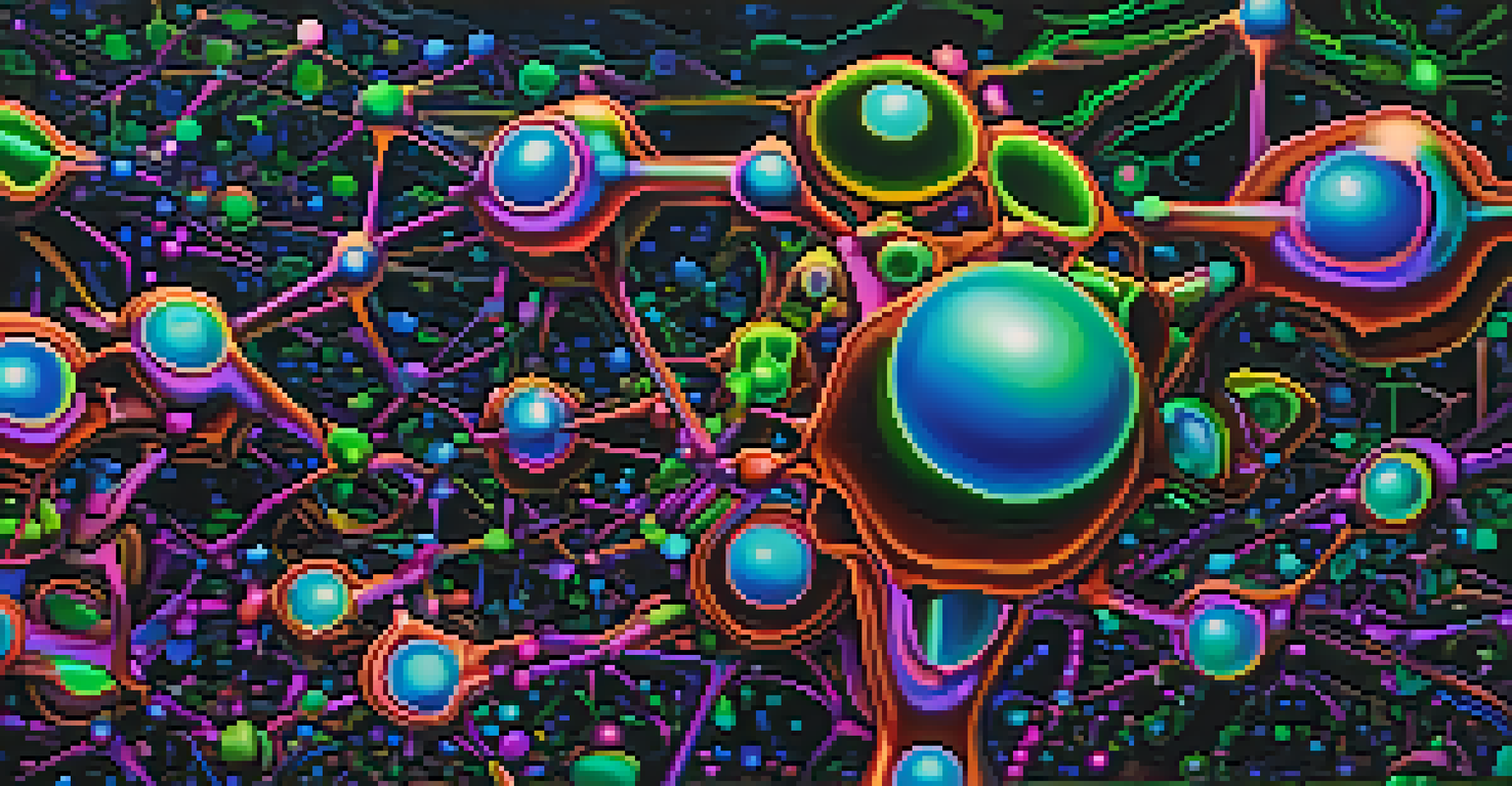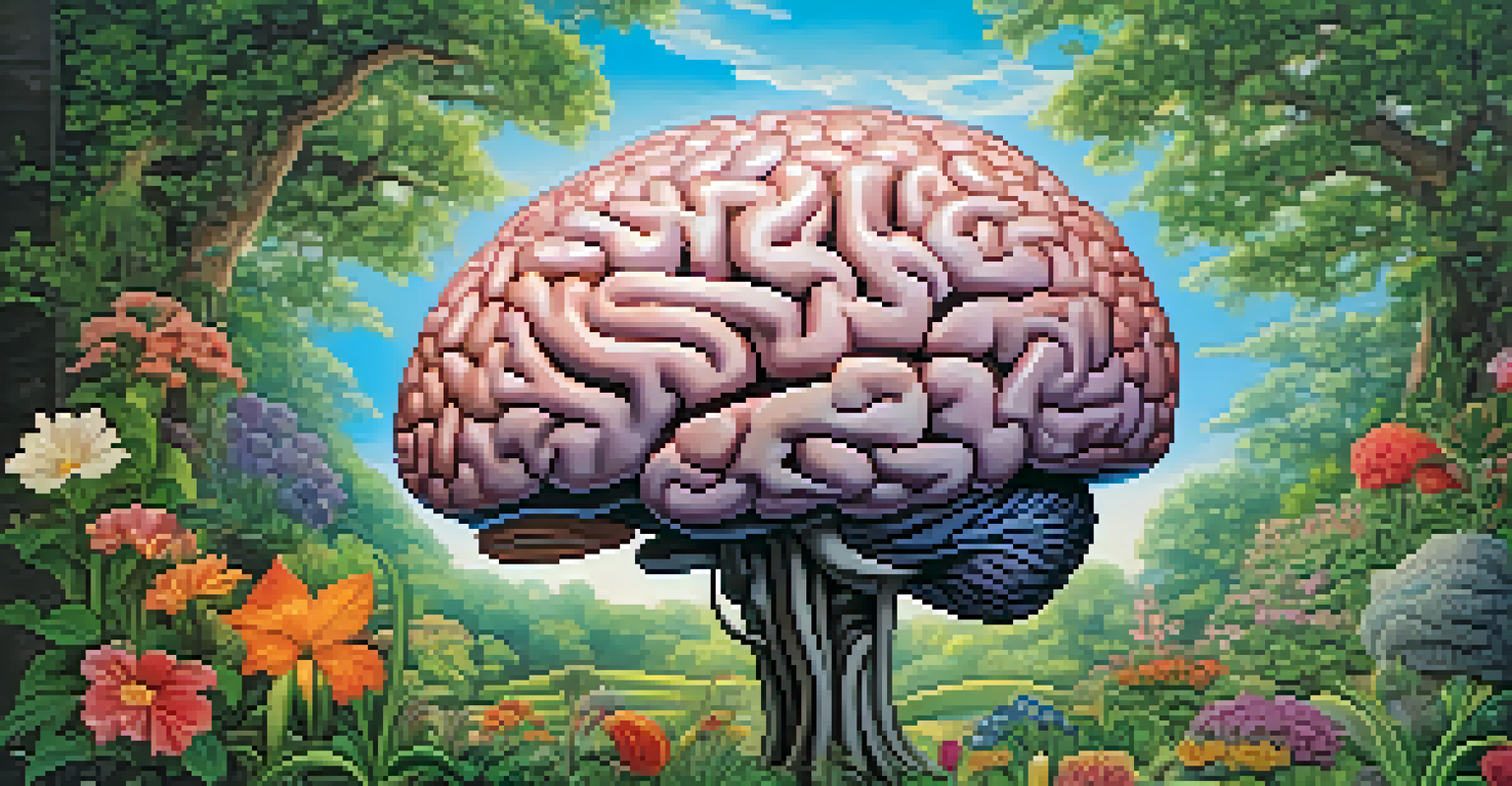Biochemical Mechanisms of Ayahuasca: What Current Studies Reveal

Understanding Ayahuasca: A Brief Overview
Ayahuasca is a traditional Amazonian brew known for its psychoactive properties. Composed mainly of the Banisteriopsis caapi vine and the Psychotria viridis leaf, it has been used for centuries in spiritual ceremonies. Many people seek out Ayahuasca today for its potential therapeutic benefits, including enhanced emotional healing and personal insight.
The experience of Ayahuasca can be a powerful catalyst for personal growth and healing.
The brew's effects are primarily attributed to two compounds: DMT (dimethyltryptamine) and MAOIs (monoamine oxidase inhibitors). DMT is a powerful hallucinogen that can alter perception and consciousness when ingested. The MAOIs found in the vine prevent the breakdown of DMT in the stomach, allowing it to enter the bloodstream and exert its effects.
As interest in Ayahuasca grows, researchers are keen to uncover the biochemical mechanisms behind its effects. Current studies aim to understand how these compounds interact with the brain, potentially paving the way for new therapeutic applications.
The Role of DMT in Ayahuasca's Effects
DMT is often referred to as the 'spirit molecule' due to its profound psychoactive effects. When consumed in Ayahuasca, it leads to intense visual and auditory experiences, often described as a journey into one's inner self. This powerful experience can facilitate emotional release and deep introspection.

Research indicates that DMT interacts with serotonin receptors in the brain, particularly the 5-HT2A receptor. This interaction is essential for producing altered states of consciousness and can contribute to feelings of interconnectedness and unity. It’s as if DMT opens a door to parts of the mind that are usually locked away.
Ayahuasca Promotes Emotional Healing
The brew helps individuals confront unresolved trauma and emotional pain, often leading to profound cathartic releases.
Understanding how DMT works biochemically could unlock new insights into mental health treatment. For example, some studies suggest it may help alleviate symptoms of anxiety and depression, providing a natural alternative to traditional therapies.
How MAOIs Enhance DMT’s Effects
The MAOIs in Ayahuasca play a crucial role by allowing DMT to exert its effects for an extended period. Normally, DMT is rapidly broken down in the digestive system by the enzyme monoamine oxidase, rendering it ineffective if taken alone. The MAOIs inhibit this enzyme, letting DMT reach the brain and produce its unique effects.
Ayahuasca is not just a journey into the self; it’s a journey into the heart of the universe.
This interaction is akin to having a key that unlocks a door, allowing one to explore the vast landscapes of the mind. As the DMT takes effect, users may experience profound realizations and emotional clarity, which can be transformative in nature.
Current research continues to explore the precise impact of these MAOIs on neurochemistry. Understanding this relationship could enhance the therapeutic use of Ayahuasca, particularly in the treatment of various psychological conditions.
Neuroplasticity: A Key Benefit of Ayahuasca
One of the most exciting areas of research surrounding Ayahuasca is its potential to promote neuroplasticity. Neuroplasticity is the brain's ability to reorganize itself by forming new neural connections. This process is vital for learning, memory, and recovery from trauma.
Studies suggest that the compounds in Ayahuasca may stimulate neurogenesis, the growth of new neurons, particularly in the hippocampus, an area of the brain associated with memory and emotional regulation. This is particularly promising for individuals dealing with conditions like PTSD or depression.
DMT and MAOIs Work Together
DMT, combined with MAOIs, enhances the psychoactive experience by preventing its breakdown, allowing for deeper exploration of consciousness.
Imagine your brain as a garden; Ayahuasca may help cultivate new plants, allowing for new thoughts and perspectives to flourish. As more research emerges, the implications for mental health treatment could be significant.
Ayahuasca's Impact on Emotional Healing
Many individuals report profound emotional healing experiences after consuming Ayahuasca. The brew is thought to help users confront unresolved trauma or emotional pain, often leading to cathartic release. This process can feel like peeling back layers of an onion, revealing deeper issues that need to be addressed.
Research shows that Ayahuasca may increase levels of brain-derived neurotrophic factor (BDNF), which supports neuron survival and growth. Higher BDNF levels can enhance emotional resilience and coping mechanisms, making it easier for individuals to face life's challenges.
This emotional healing aspect of Ayahuasca has attracted attention from mental health professionals. As they learn more about its biochemical effects, they may incorporate it into holistic treatment plans for various emotional and psychological issues.
Potential Risks and Considerations
While Ayahuasca offers potential benefits, it is not without risks. The intense emotional experiences and altered states of consciousness can be overwhelming for some individuals. It's essential for users to approach Ayahuasca with caution and ideally under the guidance of experienced practitioners.
Additionally, interactions between MAOIs and certain medications can lead to severe side effects, including hypertensive crises. It's crucial for anyone considering Ayahuasca to consult with a healthcare professional, especially if they are on medication or have underlying health conditions.
Neuroplasticity and Mental Health
Ayahuasca may stimulate neuroplasticity, promoting the growth of new neurons and potentially aiding recovery from conditions like PTSD and depression.
Just as one wouldn't dive into deep waters without knowing how to swim, approaching Ayahuasca requires knowledge and preparation. Understanding both the benefits and risks can help individuals make informed decisions about their journeys.
Future Directions of Ayahuasca Research
As interest in Ayahuasca continues to grow, so does the need for rigorous scientific research. Future studies are likely to delve deeper into the biochemical mechanisms at play, exploring how the brew can be effectively used in therapeutic settings. This could involve clinical trials assessing its efficacy for various mental health conditions.
Researchers are also examining the long-term effects of Ayahuasca use, particularly concerning emotional well-being and psychological health. Understanding how these compounds interact with the brain over time will be crucial for establishing protocols for safe and beneficial use.

Just like a new frontier waiting to be explored, the world of Ayahuasca research is ripe with potential. As scientists uncover more about its mechanisms, the healing possibilities may expand, offering hope and healing to many.